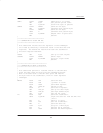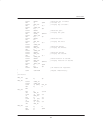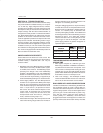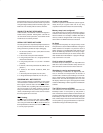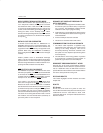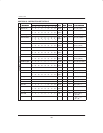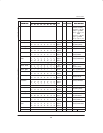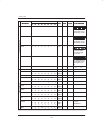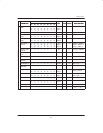
USER’S GUIDE
050396 164/173
165
lithium batteries have a very long time constant. Putting
the device on the shelf for one to two weeks may restore
enough voltage to battery back the memory again. The
lifetime of such a battery will be reduced, however.
UNABLE TO INVOKE STOP MODE
Unlike the 8051, the STOP bit in the PCON register is
Timed Access protected. Existing 8051 code will not
use the Timed Access procedure, so the STOP mode
would not be successfully invoked.
SERIAL PORT DOES NOT WORK
The serial port is not a complicated peripheral, but there
are many elements that need to be initialized. The fol-
lowing checklist is provided to help in debugging.
1. Are the P3.0 (RXD) and P3.1 (TXD) bits in the Port
3 SFR latch set to 1?
2. Is the correct serial port mode selected?
3. If using serial port mode 1 or 3, is appropriate timer
reload value selected?
4. If using serial port mode 1 or 3, is timer 1 enabled?
(TCON.6)
5. If desired, is the serial port doubler bit, SMOD, set?
(PCON.7)
6. If desired, is the receiver enable bit, REN, set?
(SCON.4)
7. Is the serial port interrupt bit, ES, set? (IE.4)
8. Is the global interrupt enable bit, EA, set? (IE.7)
PROGRAM WILL NOT EXECUTE
This is a general category of complaint. In most cases
more information is needed. Prior to calling for applica-
tions support, check the status of ALE, PSEN, XTAL2,
Ports, and RST. Also, try adding instructions that write a
value to the ports to see which sections of code are
being run and which are not (similar to using print state-
ments). The following is a list of some common reasons
that the program will not execute.
EA is floating
The EA pin has an internal pull down resistor. If EA is
allowed to float, it assumes an active state which pre-
vents using NV RAM. When EA
=0, the device will use
the Expanded Bus on Ports 0 and 2. Connect EA directly
to +5V for proper operation.
Crystal is not running
Check the capacitance used with the crystals. Approxi-
mately 20–40 pF is typical. Take note of any stray
capacitance that could increase the actual loading.
Memory map is not configured
If the developer has not used the Bootstrap Loader to
select the correct memory map, it may be incompatible
with the software. For example, a DS2251 with 64K of
memory could be configured with a 32K range. Code
above 32K in NV RAM would not be executed.
No Stack
C programmers frequently use a large memory model.
This places the C stack in MOVX RAM area. The typical
default address for compilers is to place the stack at
0000h. A device in a Partitionable mode will not have
MOVX NV RAM begin at 0000h. The C start up configu-
ration should be altered to put the stack and any other
data variables above the Partition. C programs will typi-
cally crash if there is no stack.
Code is written for an 8052
The 8052 family has 256 bytes of on chip RAM and a
third timer. Secure Microcontroller family devices are
8051 derivatives and do not have these resources.
Watchdog is running and unsupported
If the Watchdog is enabled but not supported by soft-
ware, it will reset the microprocessor at intervals of
122.8 ms with a 12 MHz crystal. If writing to an LCD dis-
play or similar activity, the initialization may take more
time that this. The code would appear not to run since
the display would never get it message printed. Make
certain the Watchdog is either supported or disabled in
software.
The CRC bit is set on a DS5001
If the CRC bit is set, the DS5001 CPU will invoke the
Bootstrap Loader on each power up and perform a
CRC. If the answer does not match the stored value, the
processor will remain in the loader mode. If the user has
inadvertently set this bit and is not actually using the
CRC, it will surely be incorrect and will invoke the loader
on each power up. A program will seem to run (the inter-
nal ROM checking the NV RAM) then stop.



